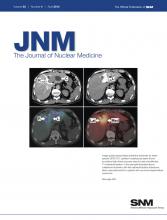Radioembolization dosimetry: Traino and colleagues offer an overview of locoregional 90Y radioembolization techniques and absorbed doses in liver tumors, providing background and context for a related article in this issue of JNM.Page 509
Breast tumor blood flow: Cochet and colleagues use 18F-FDG PET to evaluate the relationship of tumor blood flow and glucose metabolism with angiogenesis and proliferation markers in newly diagnosed breast cancer.Page 512
PET and CT perfusion in NSCLC: Sauter and colleagues investigate correlations between glucose metabolism registered by 18F-FDG PET/CT and tumor perfusion quantified by volume perfusion CT and immunohistochemical markers in patients with non–small cell lung cancer.Page 521
PET as surrogate biomarker in NSCLC: Bengtsson and colleagues assess the predictive value of early-treatment 18F-FDG PET for overall survival in non–small cell lung cancer patients treated with a targeted drug.Page 530
11C-acetate in localized prostate cancer: Mena and colleagues compare 11C-acetate PET/CT in prostate cancer, benign prostate hyperplasia, and normal prostate tissue with results from multiparametric MRI, whole-mount histopathology, and clinical markers.Page 538
Parametric PET/MRI: Park and colleagues report on the performance of parametric fusion PET/MRI based on 11C-choline PET/CT and apparent diffusion coefficient MRI maps for identification of primary prostate cancer.Page 546
Amino acid PET cost effectiveness: Heinzel and colleagues analyze the practical aspects of clinical use of amino acid PET, compared with MRI alone, for surgical resection of high-grade gliomas, from the perspective of the German health insurance system.Page 552
Artery-specific SPECT/CT partition model: Kao and colleagues describe and validate an image-guided personalized predictive dosimetric technique for 90Y radioembolization, integrating catheter-directed CT hepatic angiography, 99mTc-macroaggregated albumin SPECT/CT, and partition modeling.Page 559
PET and GIST therapy: Van den Abbeele and colleagues explore correlations between metabolic response assessed by 18F-FDG PET and objective response, glucose transporter type 4 expression, and genotype in patients with gastrointestinal stromal tumors undergoing neoadjuvant imatinib mesylate therapy.Page 567

Coronary artery plaque metabolic imaging: Cheng and colleagues use coregistered PET and coronary CT angiography to examine 18F-FDG uptake at culprit sites of acute myocardial infarction after percutaneous coronary stenting.Page 575

SPECT vs. MRI in cardiomyopathy: Xie and colleagues compare electrocardiogram-gated blood-pool SPECT for assessment of left and right ventricular ejection fractions, end-diastolic volumes, and end-systolic volumes with MRI results in patients with dilated cardiomyopathy.Page 584
PET indices for AD: Caroli and colleagues compare the relative abilities of three 18F-FDG PET data analysis techniques to distinguish patients with early Alzheimer disease dementia or progressive mild cognitive impairment from cognitively normal adults.Page 592
PET and endotoxin administration: Hannestad and colleagues use 18F-FDG PET to identify human brain regions involved in the response to endotoxin administration, with results that enhance understanding of the relationship between depression and systemic inflammation.Page 601

SiPM PET/MRI: Yoon and colleagues describe the development and architecture of a system based on multichannel silicone photomultiplier arrays to allow simultaneous MRI and PET.Page 608

PET marrow RIT dosimetry: Schwartz and colleagues detail and validate a method for directly estimating red marrow activity concentration and self-dose components of absorbed radiation dose to red marrow in radiotherapy, based on PET/CT of two 124I-labeled antibodies.Page 615
Improving 11C-PiB PET quantification: Zhou and colleagues use a recently developed relative equilibrium–based graphical plot method to enhance and simplify the 2 most commonly used methods for quantification of 11C-Pittsburgh compound B PET.Page 622

PET and trastuzumab response: Kramer-Marek and colleagues describe a small-animal study on the ability of 18F-FBEM PET Affibody imaging to quantify changes in receptor expression and to predict responses to trastuzumab therapy.Page 629
Imaging diverse disease biomarkers: Busch and colleagues detail an in vivo spectral multiplexing approach for monitoring interactions among different molecules via near-infrared fluorescent Förster resonance energy, with implications in inflammation, cancer, and neurodegenerative diseases.Page 638
HSV1716 and 131I-MIBG therapy: Sorensen and colleagues report on the development of noradrenaline transporter gene–infected cells for combined targeted radiotherapy.Page 647
MI training for NM residents: Graham and Jacene review recent curriculum recommendations for residency training in molecular imaging and nuclear medicine.Page 655
ON THE COVER

Image-guided personalized predictive dosimetry by artery-specific SPECT/CT partition modeling has been shown to achieve high clinical success rates for safe and effective 90Y radioembolization. In the example illustrated, sublesional dosimetry with left radioembolization lobectomy intent was performed for a patient with recurrent hepatocellular carcinoma.See page 563.
- © 2012 by the Society of Nuclear Medicine, Inc.







